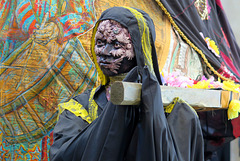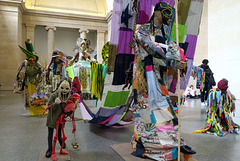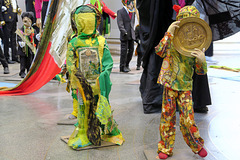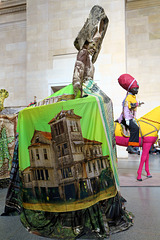MJ Maccardini (trailerfullofpix)'s photos with the keyword: hew locke
PXL 20241017 121603181-001-Exhibition Banners
| 09 Apr 2025 |
|
Great Court, British Museum. Both exhibitions were great.
IMG 8506-001-Procession 1
| 14 Mar 2023 |
|
Hew Locke's installation in the Duveen Galleries, Tate Britain.
A procession is part and parcel of the cycle of life; people gather and move together to celebrate, worship, protest, mourn, escape or even to better themselves. This is the heart of Hew Locke’s ambitious new project, The Procession.
The Procession invites visitors to ‘reflect on the cycles of history, and the ebb and flow of cultures, people and finance and power.’ Tate Britain’s founder was art lover and sugar refining magnate Henry Tate. In the installation Locke says he ‘makes links with the historical after-effects of the sugar business, almost drawing out of the walls of the building,’ also revisiting his artistic journey so far, including for example work with statues, share certificates, cardboard, rising sea levels, Carnival and the military.
Throughout, visitors will see figures who travel through space and time. Here, they carry historical and cultural baggage, from evidence of global financial and violent colonial control embellished on their clothes and banners, alongside powerful images of some of the disappearing colonial architecture of Locke’s childhood in Guyana.
The installation takes inspiration from real events and histories but overall, the figures invite us to walk alongside them, into an enlarged vision of an imagined future.
IMG 8509-001-Procession 3
| 14 Mar 2023 |
|
Hew Locke's installation in the Duveen Galleries, Tate Britain.
A procession is part and parcel of the cycle of life; people gather and move together to celebrate, worship, protest, mourn, escape or even to better themselves. This is the heart of Hew Locke’s ambitious new project, The Procession.
The Procession invites visitors to ‘reflect on the cycles of history, and the ebb and flow of cultures, people and finance and power.’ Tate Britain’s founder was art lover and sugar refining magnate Henry Tate. In the installation Locke says he ‘makes links with the historical after-effects of the sugar business, almost drawing out of the walls of the building,’ also revisiting his artistic journey so far, including for example work with statues, share certificates, cardboard, rising sea levels, Carnival and the military.
Throughout, visitors will see figures who travel through space and time. Here, they carry historical and cultural baggage, from evidence of global financial and violent colonial control embellished on their clothes and banners, alongside powerful images of some of the disappearing colonial architecture of Locke’s childhood in Guyana.
The installation takes inspiration from real events and histories but overall, the figures invite us to walk alongside them, into an enlarged vision of an imagined future.
IMG 8508-001-Procession 2
| 14 Mar 2023 |
|
|
Hew Locke's installation in the Duveen Galleries, Tate Britain.
A procession is part and parcel of the cycle of life; people gather and move together to celebrate, worship, protest, mourn, escape or even to better themselves. This is the heart of Hew Locke’s ambitious new project, The Procession.
The Procession invites visitors to ‘reflect on the cycles of history, and the ebb and flow of cultures, people and finance and power.’ Tate Britain’s founder was art lover and sugar refining magnate Henry Tate. In the installation Locke says he ‘makes links with the historical after-effects of the sugar business, almost drawing out of the walls of the building,’ also revisiting his artistic journey so far, including for example work with statues, share certificates, cardboard, rising sea levels, Carnival and the military.
Throughout, visitors will see figures who travel through space and time. Here, they carry historical and cultural baggage, from evidence of global financial and violent colonial control embellished on their clothes and banners, alongside powerful images of some of the disappearing colonial architecture of Locke’s childhood in Guyana.
The installation takes inspiration from real events and histories but overall, the figures invite us to walk alongside them, into an enlarged vision of an imagined future.
IMG 8511-001-Procession 5
| 14 Mar 2023 |
|
|
|
Hew Locke's installation in the Duveen Galleries, Tate Britain.
A procession is part and parcel of the cycle of life; people gather and move together to celebrate, worship, protest, mourn, escape or even to better themselves. This is the heart of Hew Locke’s ambitious new project, The Procession.
The Procession invites visitors to ‘reflect on the cycles of history, and the ebb and flow of cultures, people and finance and power.’ Tate Britain’s founder was art lover and sugar refining magnate Henry Tate. In the installation Locke says he ‘makes links with the historical after-effects of the sugar business, almost drawing out of the walls of the building,’ also revisiting his artistic journey so far, including for example work with statues, share certificates, cardboard, rising sea levels, Carnival and the military.
Throughout, visitors will see figures who travel through space and time. Here, they carry historical and cultural baggage, from evidence of global financial and violent colonial control embellished on their clothes and banners, alongside powerful images of some of the disappearing colonial architecture of Locke’s childhood in Guyana.
The installation takes inspiration from real events and histories but overall, the figures invite us to walk alongside them, into an enlarged vision of an imagined future.
IMG 8513-001-Procession 6
| 14 Mar 2023 |
|
Hew Locke's installation in the Duveen Galleries, Tate Britain.
A procession is part and parcel of the cycle of life; people gather and move together to celebrate, worship, protest, mourn, escape or even to better themselves. This is the heart of Hew Locke’s ambitious new project, The Procession.
The Procession invites visitors to ‘reflect on the cycles of history, and the ebb and flow of cultures, people and finance and power.’ Tate Britain’s founder was art lover and sugar refining magnate Henry Tate. In the installation Locke says he ‘makes links with the historical after-effects of the sugar business, almost drawing out of the walls of the building,’ also revisiting his artistic journey so far, including for example work with statues, share certificates, cardboard, rising sea levels, Carnival and the military.
Throughout, visitors will see figures who travel through space and time. Here, they carry historical and cultural baggage, from evidence of global financial and violent colonial control embellished on their clothes and banners, alongside powerful images of some of the disappearing colonial architecture of Locke’s childhood in Guyana.
The installation takes inspiration from real events and histories but overall, the figures invite us to walk alongside them, into an enlarged vision of an imagined future.
IMG 8517-001-Procession 8
| 14 Mar 2023 |
|
Hew Locke's installation in the Duveen Galleries, Tate Britain.
A procession is part and parcel of the cycle of life; people gather and move together to celebrate, worship, protest, mourn, escape or even to better themselves. This is the heart of Hew Locke’s ambitious new project, The Procession.
The Procession invites visitors to ‘reflect on the cycles of history, and the ebb and flow of cultures, people and finance and power.’ Tate Britain’s founder was art lover and sugar refining magnate Henry Tate. In the installation Locke says he ‘makes links with the historical after-effects of the sugar business, almost drawing out of the walls of the building,’ also revisiting his artistic journey so far, including for example work with statues, share certificates, cardboard, rising sea levels, Carnival and the military.
Throughout, visitors will see figures who travel through space and time. Here, they carry historical and cultural baggage, from evidence of global financial and violent colonial control embellished on their clothes and banners, alongside powerful images of some of the disappearing colonial architecture of Locke’s childhood in Guyana.
The installation takes inspiration from real events and histories but overall, the figures invite us to walk alongside them, into an enlarged vision of an imagined future.
IMG 8519-001-Procession 9
| 14 Mar 2023 |
|
Hew Locke's installation in the Duveen Galleries, Tate Britain.
A procession is part and parcel of the cycle of life; people gather and move together to celebrate, worship, protest, mourn, escape or even to better themselves. This is the heart of Hew Locke’s ambitious new project, The Procession.
The Procession invites visitors to ‘reflect on the cycles of history, and the ebb and flow of cultures, people and finance and power.’ Tate Britain’s founder was art lover and sugar refining magnate Henry Tate. In the installation Locke says he ‘makes links with the historical after-effects of the sugar business, almost drawing out of the walls of the building,’ also revisiting his artistic journey so far, including for example work with statues, share certificates, cardboard, rising sea levels, Carnival and the military.
Throughout, visitors will see figures who travel through space and time. Here, they carry historical and cultural baggage, from evidence of global financial and violent colonial control embellished on their clothes and banners, alongside powerful images of some of the disappearing colonial architecture of Locke’s childhood in Guyana.
The installation takes inspiration from real events and histories but overall, the figures invite us to walk alongside them, into an enlarged vision of an imagined future.
IMG 8522-001-Procession 10
| 14 Mar 2023 |
|
Hew Locke's installation in the Duveen Galleries, Tate Britain.
A procession is part and parcel of the cycle of life; people gather and move together to celebrate, worship, protest, mourn, escape or even to better themselves. This is the heart of Hew Locke’s ambitious new project, The Procession.
The Procession invites visitors to ‘reflect on the cycles of history, and the ebb and flow of cultures, people and finance and power.’ Tate Britain’s founder was art lover and sugar refining magnate Henry Tate. In the installation Locke says he ‘makes links with the historical after-effects of the sugar business, almost drawing out of the walls of the building,’ also revisiting his artistic journey so far, including for example work with statues, share certificates, cardboard, rising sea levels, Carnival and the military.
Throughout, visitors will see figures who travel through space and time. Here, they carry historical and cultural baggage, from evidence of global financial and violent colonial control embellished on their clothes and banners, alongside powerful images of some of the disappearing colonial architecture of Locke’s childhood in Guyana.
The installation takes inspiration from real events and histories but overall, the figures invite us to walk alongside them, into an enlarged vision of an imagined future.
IMG 8525-001-Procession 12
| 14 Mar 2023 |
|
Hew Locke's installation in the Duveen Galleries, Tate Britain.
A procession is part and parcel of the cycle of life; people gather and move together to celebrate, worship, protest, mourn, escape or even to better themselves. This is the heart of Hew Locke’s ambitious new project, The Procession.
The Procession invites visitors to ‘reflect on the cycles of history, and the ebb and flow of cultures, people and finance and power.’ Tate Britain’s founder was art lover and sugar refining magnate Henry Tate. In the installation Locke says he ‘makes links with the historical after-effects of the sugar business, almost drawing out of the walls of the building,’ also revisiting his artistic journey so far, including for example work with statues, share certificates, cardboard, rising sea levels, Carnival and the military.
Throughout, visitors will see figures who travel through space and time. Here, they carry historical and cultural baggage, from evidence of global financial and violent colonial control embellished on their clothes and banners, alongside powerful images of some of the disappearing colonial architecture of Locke’s childhood in Guyana.
The installation takes inspiration from real events and histories but overall, the figures invite us to walk alongside them, into an enlarged vision of an imagined future.
IMG 8528-001-Procession 14
| 14 Mar 2023 |
|
Hew Locke's installation in the Duveen Galleries, Tate Britain.
A procession is part and parcel of the cycle of life; people gather and move together to celebrate, worship, protest, mourn, escape or even to better themselves. This is the heart of Hew Locke’s ambitious new project, The Procession.
The Procession invites visitors to ‘reflect on the cycles of history, and the ebb and flow of cultures, people and finance and power.’ Tate Britain’s founder was art lover and sugar refining magnate Henry Tate. In the installation Locke says he ‘makes links with the historical after-effects of the sugar business, almost drawing out of the walls of the building,’ also revisiting his artistic journey so far, including for example work with statues, share certificates, cardboard, rising sea levels, Carnival and the military.
Throughout, visitors will see figures who travel through space and time. Here, they carry historical and cultural baggage, from evidence of global financial and violent colonial control embellished on their clothes and banners, alongside powerful images of some of the disappearing colonial architecture of Locke’s childhood in Guyana.
The installation takes inspiration from real events and histories but overall, the figures invite us to walk alongside them, into an enlarged vision of an imagined future.
IMG 8530-001-Procession 15
| 14 Mar 2023 |
|
Hew Locke's installation in the Duveen Galleries, Tate Britain.
A procession is part and parcel of the cycle of life; people gather and move together to celebrate, worship, protest, mourn, escape or even to better themselves. This is the heart of Hew Locke’s ambitious new project, The Procession.
The Procession invites visitors to ‘reflect on the cycles of history, and the ebb and flow of cultures, people and finance and power.’ Tate Britain’s founder was art lover and sugar refining magnate Henry Tate. In the installation Locke says he ‘makes links with the historical after-effects of the sugar business, almost drawing out of the walls of the building,’ also revisiting his artistic journey so far, including for example work with statues, share certificates, cardboard, rising sea levels, Carnival and the military.
Throughout, visitors will see figures who travel through space and time. Here, they carry historical and cultural baggage, from evidence of global financial and violent colonial control embellished on their clothes and banners, alongside powerful images of some of the disappearing colonial architecture of Locke’s childhood in Guyana.
The installation takes inspiration from real events and histories but overall, the figures invite us to walk alongside them, into an enlarged vision of an imagined future.
IMG 8527-001-Procession 13
| 14 Mar 2023 |
|
Hew Locke's installation in the Duveen Galleries, Tate Britain.
A procession is part and parcel of the cycle of life; people gather and move together to celebrate, worship, protest, mourn, escape or even to better themselves. This is the heart of Hew Locke’s ambitious new project, The Procession.
The Procession invites visitors to ‘reflect on the cycles of history, and the ebb and flow of cultures, people and finance and power.’ Tate Britain’s founder was art lover and sugar refining magnate Henry Tate. In the installation Locke says he ‘makes links with the historical after-effects of the sugar business, almost drawing out of the walls of the building,’ also revisiting his artistic journey so far, including for example work with statues, share certificates, cardboard, rising sea levels, Carnival and the military.
Throughout, visitors will see figures who travel through space and time. Here, they carry historical and cultural baggage, from evidence of global financial and violent colonial control embellished on their clothes and banners, alongside powerful images of some of the disappearing colonial architecture of Locke’s childhood in Guyana.
The installation takes inspiration from real events and histories but overall, the figures invite us to walk alongside them, into an enlarged vision of an imagined future.
IMG 8523-001-Procession 11
| 14 Mar 2023 |
|
Hew Locke's installation in the Duveen Galleries, Tate Britain.
A procession is part and parcel of the cycle of life; people gather and move together to celebrate, worship, protest, mourn, escape or even to better themselves. This is the heart of Hew Locke’s ambitious new project, The Procession.
The Procession invites visitors to ‘reflect on the cycles of history, and the ebb and flow of cultures, people and finance and power.’ Tate Britain’s founder was art lover and sugar refining magnate Henry Tate. In the installation Locke says he ‘makes links with the historical after-effects of the sugar business, almost drawing out of the walls of the building,’ also revisiting his artistic journey so far, including for example work with statues, share certificates, cardboard, rising sea levels, Carnival and the military.
Throughout, visitors will see figures who travel through space and time. Here, they carry historical and cultural baggage, from evidence of global financial and violent colonial control embellished on their clothes and banners, alongside powerful images of some of the disappearing colonial architecture of Locke’s childhood in Guyana.
The installation takes inspiration from real events and histories but overall, the figures invite us to walk alongside them, into an enlarged vision of an imagined future.
IMG 8516-001-Procession 7
| 14 Mar 2023 |
|
Hew Locke's installation in the Duveen Galleries, Tate Britain.
A procession is part and parcel of the cycle of life; people gather and move together to celebrate, worship, protest, mourn, escape or even to better themselves. This is the heart of Hew Locke’s ambitious new project, The Procession.
The Procession invites visitors to ‘reflect on the cycles of history, and the ebb and flow of cultures, people and finance and power.’ Tate Britain’s founder was art lover and sugar refining magnate Henry Tate. In the installation Locke says he ‘makes links with the historical after-effects of the sugar business, almost drawing out of the walls of the building,’ also revisiting his artistic journey so far, including for example work with statues, share certificates, cardboard, rising sea levels, Carnival and the military.
Throughout, visitors will see figures who travel through space and time. Here, they carry historical and cultural baggage, from evidence of global financial and violent colonial control embellished on their clothes and banners, alongside powerful images of some of the disappearing colonial architecture of Locke’s childhood in Guyana.
The installation takes inspiration from real events and histories but overall, the figures invite us to walk alongside them, into an enlarged vision of an imagined future.
IMG 8510-001-Procession 4
| 14 Mar 2023 |
|
Hew Locke's installation in the Duveen Galleries, Tate Britain.
A procession is part and parcel of the cycle of life; people gather and move together to celebrate, worship, protest, mourn, escape or even to better themselves. This is the heart of Hew Locke’s ambitious new project, The Procession.
The Procession invites visitors to ‘reflect on the cycles of history, and the ebb and flow of cultures, people and finance and power.’ Tate Britain’s founder was art lover and sugar refining magnate Henry Tate. In the installation Locke says he ‘makes links with the historical after-effects of the sugar business, almost drawing out of the walls of the building,’ also revisiting his artistic journey so far, including for example work with statues, share certificates, cardboard, rising sea levels, Carnival and the military.
Throughout, visitors will see figures who travel through space and time. Here, they carry historical and cultural baggage, from evidence of global financial and violent colonial control embellished on their clothes and banners, alongside powerful images of some of the disappearing colonial architecture of Locke’s childhood in Guyana.
The installation takes inspiration from real events and histories but overall, the figures invite us to walk alongside them, into an enlarged vision of an imagined future.
Jump to top
RSS feed- MJ Maccardini (trailerfullofpix)'s latest photos with "hew locke" - Photos
- ipernity © 2007-2025
- Help & Contact
|
Club news
|
About ipernity
|
History |
ipernity Club & Prices |
Guide of good conduct
Donate | Group guidelines | Privacy policy | Terms of use | Statutes | In memoria -
Facebook
Twitter
















